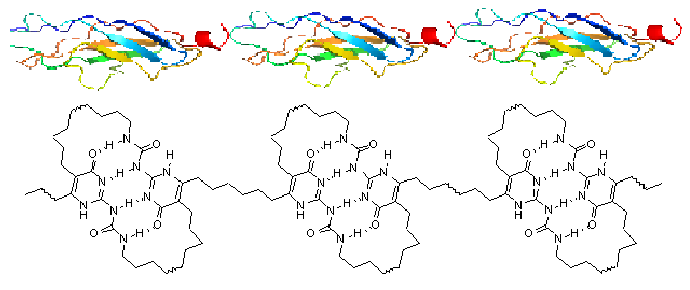POLYMERS

https://commons.wikimedia.org/w/index.php?title=User:Shaobaqian&action=edit&redlink=1
https://en.wikipedia.org/wiki/User:Shaobaqian
Polymers are substances made from lengthy, frequenting chains of molecules. The substances have unique homes, depending strictly on the Polymers are substances made from lengthy, frequenting chains of molecules. The substances have unique homes, depending strictly on the nature of the molecules being bonded and how they're bonded. Few polymers bend and stretch, like rubber and polyester. Others are difficult, like epoxies(A thermosetting polyepoxide resin used chiefly in strong adhesives, coatings, and laminates; epoxy resin. and glass.)
Polymers touch almost every factor of modern-day existence. possibilities are the majority were in touch with as a minimum one polymer-containing product — from water bottles to gadgets to tires — in the last 5 mins.
The time period polymer is often used to describe plastics, that are synthetic polymers. however, natural polymers also exist; rubber and timber, as an example, are herbal polymers that include a simple hydrocarbon, isoprene, in line with Encyclopedia Britannica. Proteins are natural polymers made of amino acids, and nucleic acids (DNA and RNA) are polymers of nucleotides — complicated molecules composed of nitrogen-containing bases, sugars and phosphoric acid, as an instance.
CHEMICAL REACTIONS
A professor of natural chemistry at the college of applied Sciences- Hermann Staudinger in Zurich, is the innovator of modern-day polymer development and improvement. His intense analysis and research inside the Nineteen Twenties led the way to fashionable manipulations of both herbal and synthetic polymers. He coined phrases which are key to expertise polymers: polymerization and macromolecules, in line with the yank Chemical Society (ACS). He turned into provided a Nobel Prize in Chemistry in 1953 "for his discoveries within the field of macromolecular chemistry."
Polymerization is the approach of making artificial polymers with the aid of combining smaller molecules, known as monomers, into a chain held collectively via covalent bonds, in step with ThoughtCo., an internet instructional resource. numerous chemical reactions — those resulting from heat and pressure, as an example — modify the chemical bonds that keep monomers together, in keeping with clinical American. The system causes the molecules to bond in a linear, branched or community shape, ensuing in polymers.
those chains of monomers also are known as macromolecules. maximum polymer chains have a string of carbon atoms as a backbone. A single macromolecule can consist of masses of heaps of monomers, in keeping with the Polymer technological know-how gaining knowledge of middle.
USES OF POLYMERS
Polymers are used in almost every region of the modern-day dwelling. Grocery baggage, soda and water bottles, plastic bags and bottles, coating on electrical wires, fabric fibers, telephones, computers, meals packaging, auto elements, and toys all include polymers.
Even more-sophisticated technology makes use of polymers. for instance, "the membranes for water desalination, providers used in managed drug release and biopolymers for tissue engineering all use polymers," in line with the ACS.
popular polymers for production include polyethylene and polypropylene. Their molecules can include 10,000 to 200,000 monomers.
at some stage in a polymerization reaction, a huge wide variety of monomers turn out to be connected by using covalent bonds to form an unmarried lengthy molecule, a polymer.
The period of a polymerization response, an outsized wide selection of monomers become connected by exploitation valency bonds to create an unwedded drawn-out molecule, a polymer.
credit: LibreTexts
FUTURE OF POLYMERS
Researchers are experimenting with many specific forms of polymers, aiming to further medicine improvement and enhance merchandise we already use.
for example, carbon polymers are being advanced and greater for the automobile enterprise.
"Carbon-fiber-bolstered polymer (CFRP) composites — additionally called carbon-fiber laminates — are the next-generation substances for making cars lighter, extra gas efficient and safer," in step with a 2016 stay technological know-how column by suggests that of Nikhil Gupta, associate degree supporter academic, and Steven Zeltmann, a scholar investigator, each within the Composite materials and Mechanics Laboratory of the Mechanical and region Engineering department at American state university Tandon school of Engineering.
"Carbon laminate is extraordinarily sturdy and stiff owing to its woven layers of nearly natural carbon fibers warranted along by suggests that of a hardened plastic, which has synthetic resin." [The Carbon-Fiber Future: It's regarding quite Speed] Polymers are also getting used to reinforce holograms.
In the University of Pennsylvania, scientists created a hologram on bendy polymer fabric termed PDMA that became embedded with gold nanorods, in step with a observe published online in early 2017 inside the magazine Nano Letters. This new hologram tool can hold several photos rather than simply one.
"The question we asked is, 'are we able to encode a couple of bits of data in a hologram?'" Ritesh Agarwal, research leader and professor of materials technology and engineering at the College of Pennsylvania, instructed stay technological know-how. "it's a vital piece of labor, as it's the primary time someone's proven you may document more than one holographic images, and by way of simply stretching the polymer, you could basically trade the photograph."
synthetic pores and skin made of a silicone polymer may be the destiny of anti-growing old efforts. inside the form of two lotions, the polymer can be capable of tightening a person's skin, lessen the appearance of wrinkles and lessen under-eye baggage, consistent with a have a look at posted may additionally 2016 within the journal Nature Materials. Such synthetic skin may also be used to help people with skin situations, consisting of eczema, or be used as the solar block.
Reference:
https://plastics.americanchemistry.com/plastics/The-Basics/
https://www.livescience.com/60682-polymers.html
http://www.bbc.co.uk/schools/gcsebitesize/science/edexcel/fuels/hydrocarbonsrev5.shtml
Hey there, I see you are relatively new to the scientific community on steemit.. there are some small steps you can take to increase your chances to be curated by communities like steemstem: first of all you need to write original content (we check if you copy text from other websites) write interesting posts (rule of thumb is: would you read your own post?) cite your sources and use images with the right attribution (and not protected by copyright). Wish you good luck
Thanks...I'll keep that in mind.